Spicy Gochujang Chicken Meatballs
This post contains affiliate links.
These baked Spicy Gochujang Chicken Meatballs are easy to make, super juicy, and full of the BEST spicy, sweet and smoky flavors. They’re delicious as a party appetizer or served with rice as a main and fantastic for meal prep too!
Spicy, sweet, smoky, sticky, saucy and with a hint of tang. These Spicy Gochujang Chicken Meatballs are incredibly DELICIOUS!
These Korean-inspired meatballs are infused with the wonderful spicy-sweet and smoky flavors of gochujang – a Korean hot pepper paste – which makes them SO tasty! All you need is ground chicken, a handful of everyday aromatics like garlic, ginger, shallots, and spring onion (scallion), pantry spices & seasonings, and some Asian condiments to make them!
They’re very low-effort and easy to whip up because the oven takes care of all the cooking work. You just combine all the ingredients in a bowl, roll the meatballs, and then place in the oven to bake! Then brush them with a spicy-sweet-tangy gochujang glaze/sauce (DROOL) and broil briefly to let the glaze set and finish cooking the meatballs.
Sprinkle them with some toasted white and black sesame seeds and spring onion and they’re ready to be served and enjoyed by whoever tries them!
My personal favorite way to enjoy these addictive meatballs? I LOVE stuffing them in mayo slathered toasted bread with some shredded napa and/or red cabbage for a delicious and easy lunch sandwich during the week. Yumtown! 😋
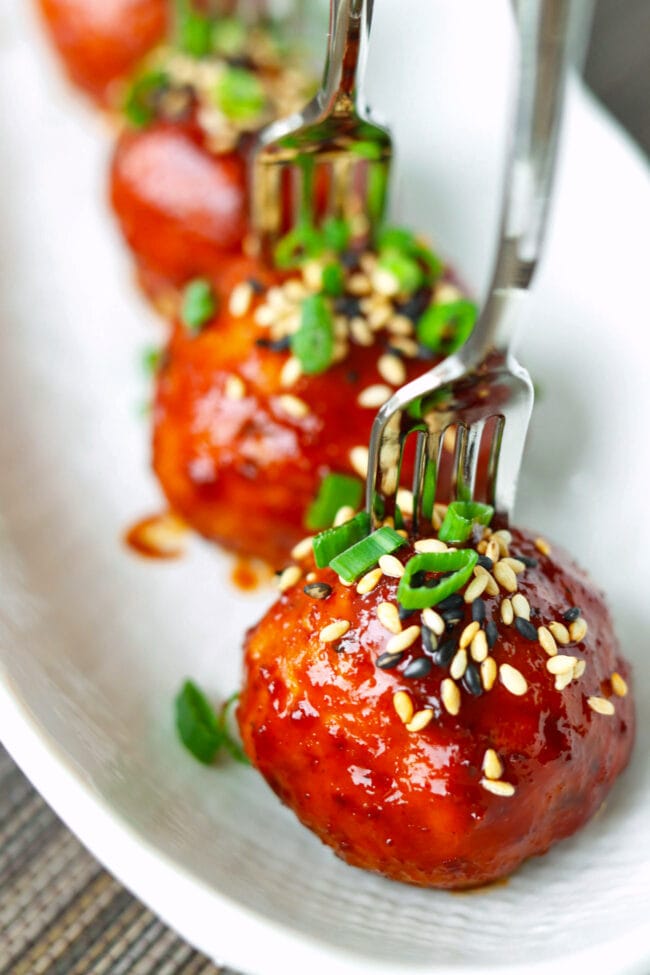
Why This Recipe Works
- Quick and easy. They’re ready in under 30 minutes! All you have to do is mix, bake, brush on glaze/sauce, broil briefly and they’re ready to go!
- DELICIOUS. They’re wonderfully juicy and tender, and spicy, smoky, sweet and saucy!
- Meal prep friendly. Make a batch today and enjoy them throughout the week!
- Customizable protein. You can use ground chicken, pork, turkey, beef or a combination of any two meats!
- Versatile. Serve them as a party appetizer, Super Bowl snack, or as a main with some rice and steamed or sautéed veggies!
Ingredient Notes
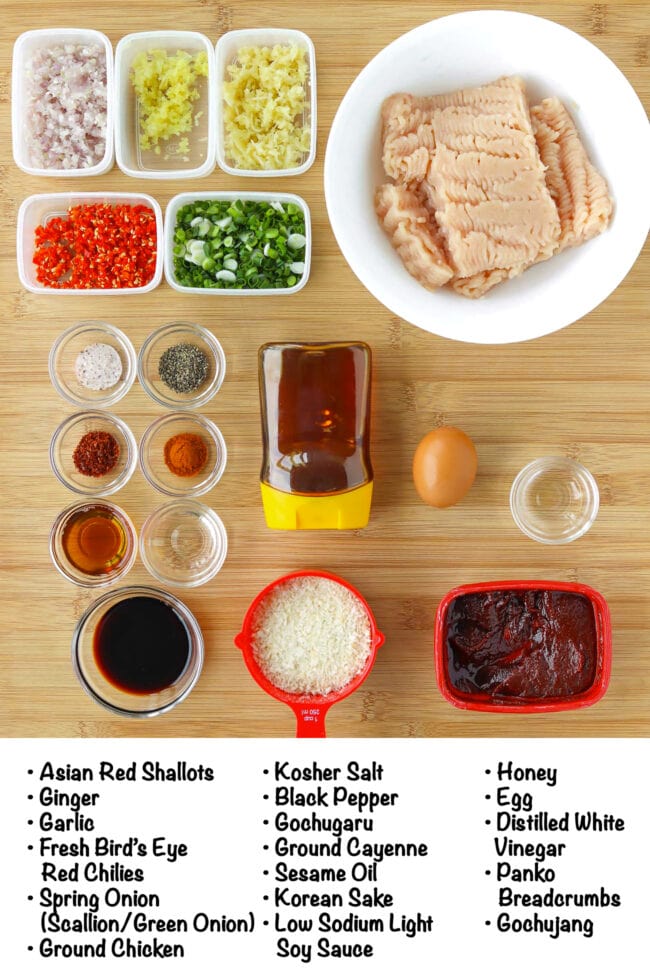
- Ground Chicken: I used ground chicken, but ground turkey will work just as well. You could also other ground meat like beef, pork, lamb or a combination. Just make sure to adjust the baking time to make sure the meatballs are cooked through.
- Panko Breadcrumbs: This is Japanese soft breadcrumbs and used to help bind everything together. They also make the meatballs less dense and moister.
- A large Egg: To also help bind all the ingredients together.
- Asian Red Shallots: Or use regular shallots or French eschalots. Alternatively, a third of a medium chopped yellow or red onion would work well too.
- Fresh Bird’s Eye Red Chilies: Or use any hot red chilies you can get in your area. Adjust the quantity to taste based on your heat level preference. Or omit to make these meatballs milder.
- Gochujang: This is a fermented Korean chili pepper paste that is highly addictive! In spite of its deep dark red color, gochujang is actually not super spicy. It has a spicy-sweet and smoky flavor and tastes great in kimchi fried rice, kimchi chicken noodles stir-fry, and also in the dipping sauce for the popular Korean fried chicken. You can find it in the Asian aisle of most mainstream supermarkets and in Korean and Asian grocery stores.
- Low Sodium Light Soy Sauce: To season the meatballs with savory umami notes, but low sodium so that we can control the salt level better.
- Korean Sake (optional): This is a Korean cooking wine and it’s used to help tenderize and bring out the flavors in the meat. You could also use Japanese sake instead. If you prefer not to cook with alcohol, simply leave it out.
- Kosher Salt: Use a little less than half the amount if using iodized table salt.
- Black Pepper: Freshly cracked for best flavor.
- Ground Cayenne (optional): For extra heat for all my spice lovers out there! Feel free to omit it if you’re not big on heat.
- Gochugaru: This is a course ground Korean chili powder. Look for it in a Korean grocery store or substitute with chili powder. Adjust quantity to taste as gochugaru comes in varying heat levels depending on the brand.
- Sesame Oil: For toasted sesame aroma and flavor.
- Canola Oil: To brush on the foil or parchment paper and to rub on your palms to make it easier to roll the meatballs without the meat sticking too your hands too much. You can use any other neutral cooking oil like vegetable, rice bran, avocado oil, etc.
- Honey: To sweeten the gochujang glaze for the meatballs.
- Distilled White Vinegar: To add a hint of tang to the gochujang glaze and balance out the spicy and savory flavors.
- For Garnish: Just some toasted white and black sesame seeds and finely chopped spring onion to make everything look pretty and appetizing!
Full ingredient list and amounts are in the recipe card below.
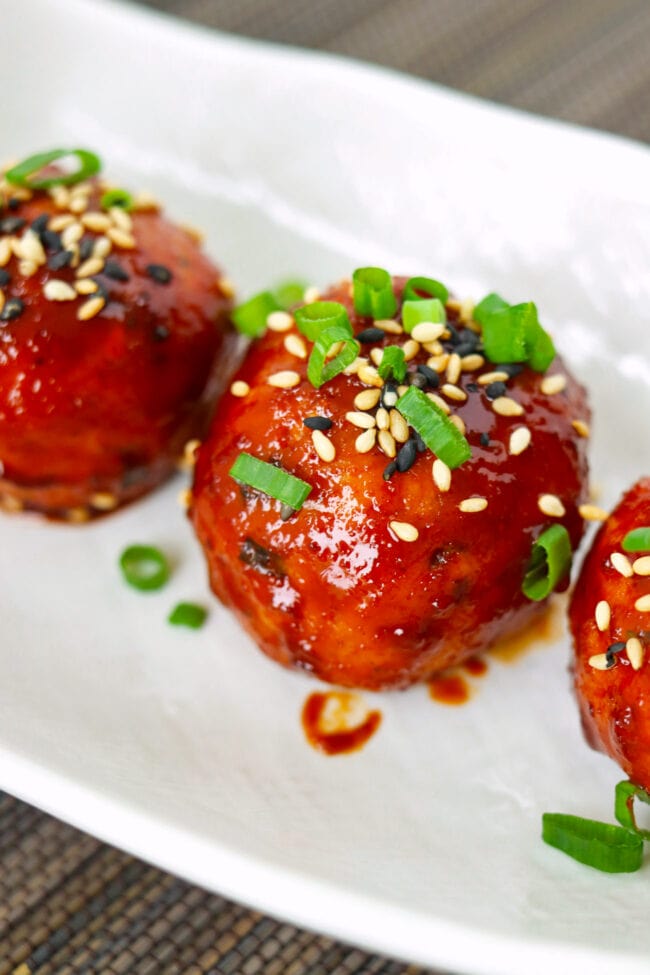
How to Make Spicy Gochujang Chicken Meatballs
1. Combine meatballs ingredients. Combine all the ingredients for the spicy gochujang chicken meatballs in a large mixing bowl.
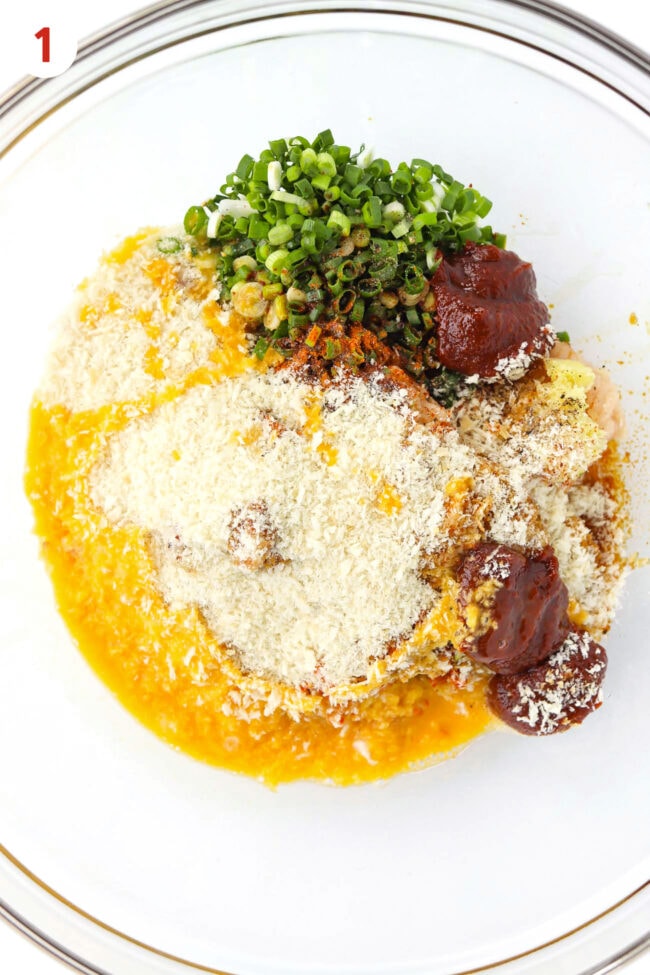
2. Roll. Roll into 20-21 balls and line them evenly apart on a large foil lined baking tray that’s lightly brushed with oil.
3. Bake. On the center rack of a preheated oven at 200°C/400°F for 20-22 minutes.
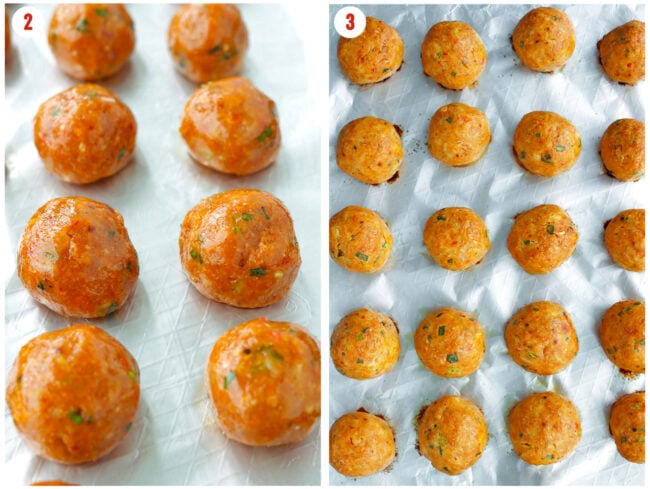
4. Brush with glaze. White the meatballs are in the oven, mix all the gochujang glaze ingredients in a medium bowl. Remove the meatballs from the oven brush with the glaze on all sides and the bottoms by gently sliding the pastry brush underneath.
5. Broil and garnish. Broil for a few brief minutes, then transfer the tray to a wire cooling rack. Sprinkle toasted white and black sesame seeds and chopped spring onion on top.
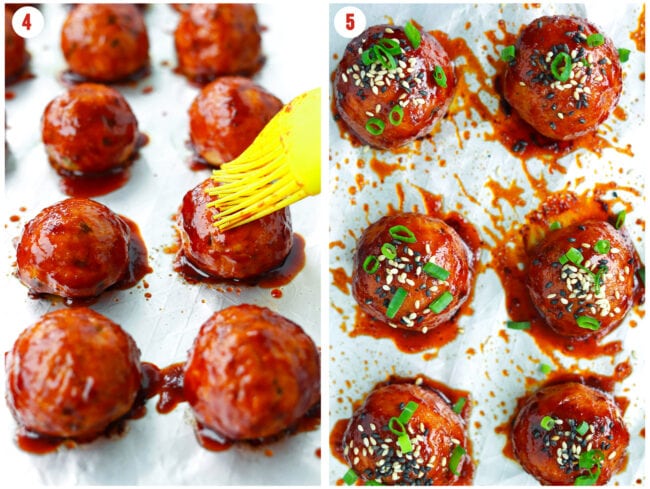
6. Serve! Serve on a platter or in individual tasting snack plates/bowls as a party appetizer on its own. Alternatively, you can enjoy with steamed rice or cooked noodles as a main dish.
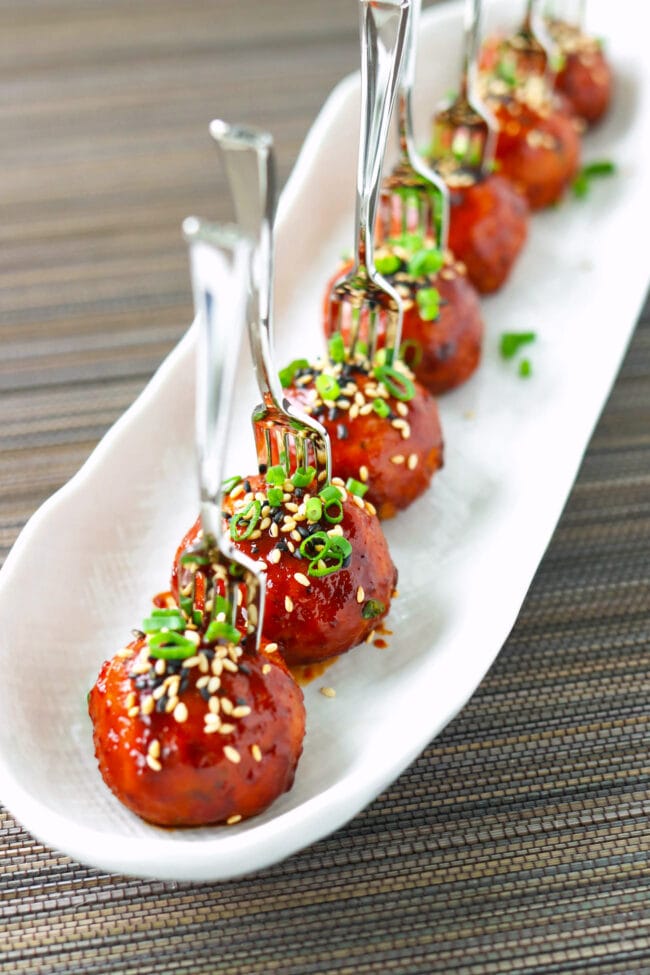
Or you can use them for meal prep and make chicken meatball lunch sandwiches during the week! (My FAVORITE!) Just think of biting into slices of toasted mayonnaise slathered bread with shredded cabbage and these juicy spicy gochujang chicken meatballs within.
YUHMM-MMY!
Full detailed instructions are in the recipe card below.
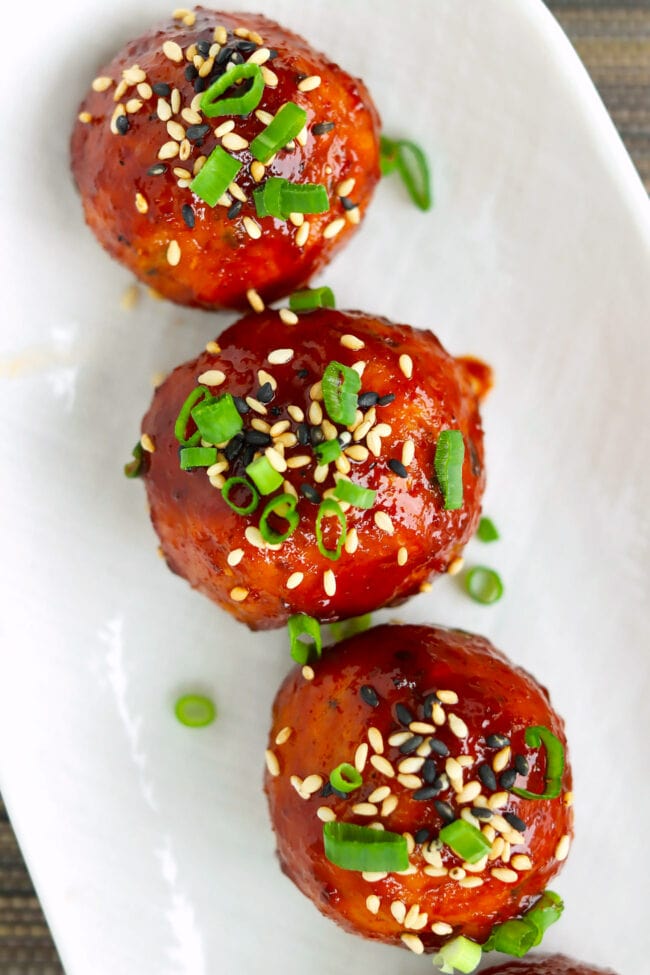
Cook’s Tips
- Oil your hands lightly to roll the meatballs. It makes it easier to roll without the meat mixture sticking to your hands too much.
- Adjust spice level to taste. Since gochujang is a little spicy, feel free to use less (1-2 tablespoons instead of 3 tablespoons) in the meatball mixture and glaze/sauce. You can also use less (or omit) the fresh red chilies, gochugaru, and ground cayenne to make them milder.
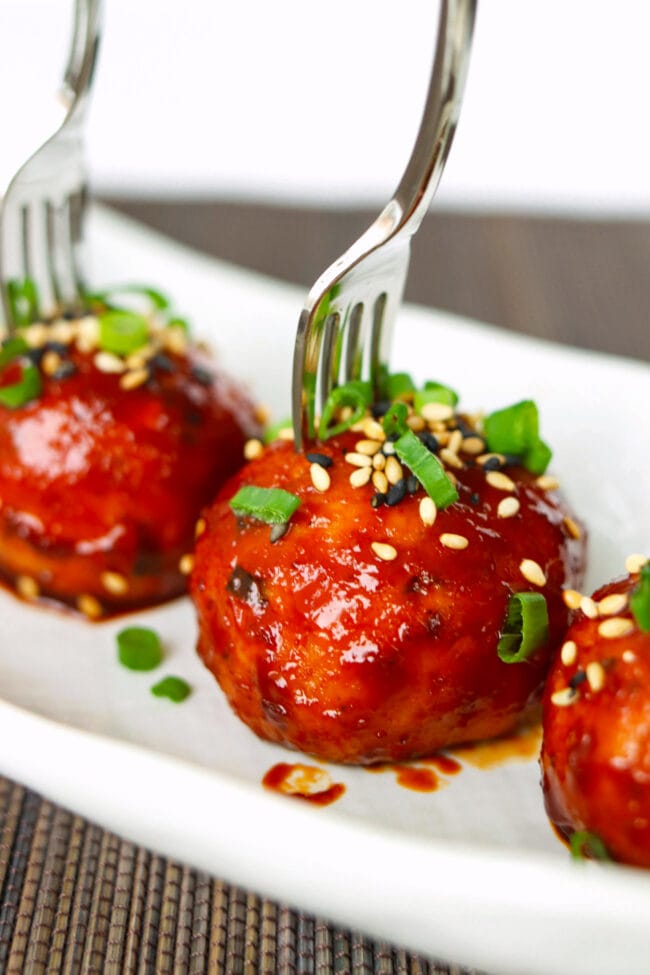
FAQs
Although the main ingredient in sambal oelek and gochujang is chili peppers, they are not interchangeable in all recipes. Gochujang is thicker and has a sticky paste texture whilst sambal oelek is waterier and like a sauce in terms of consistency. However, if you use 1-2 tablespoons instead of 3 in both the meatballs and glaze mixtures, you can certainly substitute it and make sambal oelek meatballs instead. Also omit the vinegar from the glaze as sambal oelek already has it incorporated in it and will be tangy enough.
Chung Jung One Sunchang Gochujang or their Extreme Spicy one (for spice lovers) are excellent choices. CJ Haechandle Gochujang, Sempio, and Jongga are also very good in terms of taste and quality.
Gochugaru is spicier than gochujang as it is a coarse ground chili powder. Gochujang spice levels vary from brand to brand, but is still milder than almost all gochugaru brands because it is a spicy and sweetish chili pepper paste with smoky notes.
At 400°F/200°C, chicken meatballs would take 28-30 minutes to cook through. However, these meatballs take 20-22 minutes to bake only because they will be broiled for 2-3 minutes after applying the glaze/sauce.
Variations
- Make them gluten-free. Use a gluten-free low sodium light soy sauce, gochujang (such as Wholly Gochujang), and bread crumbs.
- Make it keto. Use a low-carb or no sugar honey or other sweetener for the glaze.
- Switch up the protein. Use ground pork, beef, turkey, or lamb for the meatballs. Just check on the internal temperature of the meatballs using a digital kitchen thermometer. Chicken and turkey is cooked once the internal temperature reaches 165°F/74°C. Pork, beef, and lamb is cooked once the internal temperature reaches 145°F/63°C and only need to be baked for 18-20 minutes. You can also try using a plant-based ground meat substitute such as Beyond Beef or Impossible Pork.
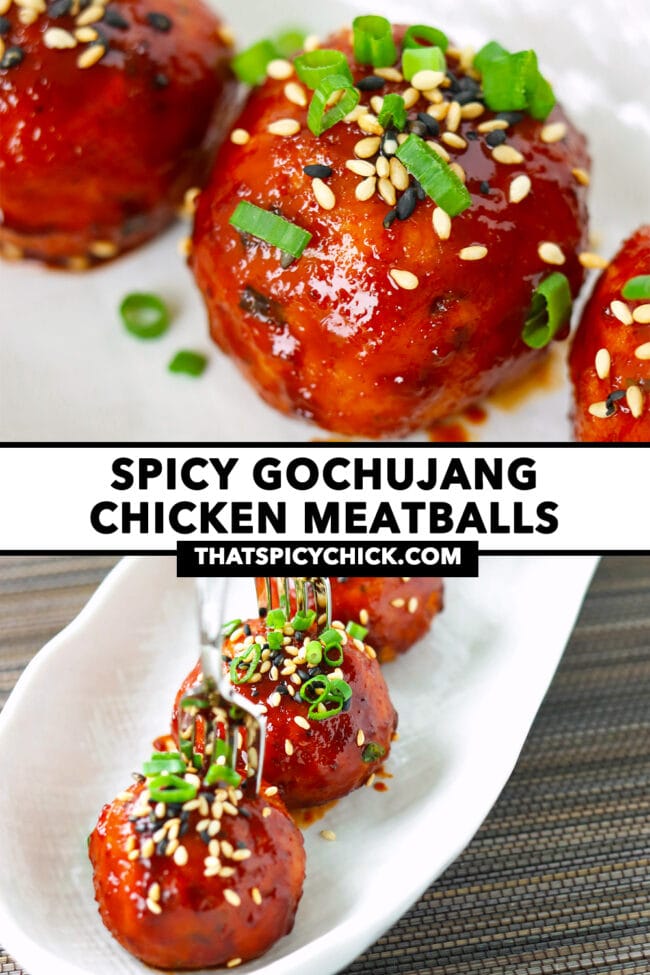
More Meatballs Recipes
- Baked Spicy Chicken Meatballs (with Thai Sweet Chili Peanut Sauce)
- Spicy Miso Ramen with Gochujang Chicken Meatballs
- Brown Butter Miso Pasta with Baked Spicy Chicken Meatballs
More Korean and Korean-inspired Recipes
- Kimchi Fried Rice with Pork Belly
- Stir-fried Kimchi Chicken Noodles
- Spicy Korean Pork Stir-fry
- Creamy Spicy Korean Udon Noodles with Bulgogi Chicken
- Or browse the entire Korean recipes collection.
MADE THIS RECIPE? If you make this recipe, leave a comment below and let me know how you liked it! Take a photo and tag it with @thatspicychick on Instagram and hashtag it #thatspicychick and I’ll be sure to share your masterpiece!
STAY CONNECTED! You can also follow me on Pinterest, Facebook or Instagram. Sign up for my email list to get my latest recipe in your inbox weekly!
PrintSpicy Gochujang Chicken Meatballs
Easy to make, super juicy, and full of the BEST spicy, sweet and smoky flavors! These baked Spicy Gochujang Chicken Meatballs are delicious as a party appetizer or main, and fantastic for meal prep too!
- Prep Time: 20
- Cook Time: 25
- Total Time: 45 minutes
- Yield: 21 1x
- Category: Appetizer
- Method: Bake
- Cuisine: Korean-inspired
Ingredients
For the Spicy Gochujang Chicken Meatballs:
- 480 grams / 1.1 pounds Ground Chicken
- 40 grams / ¾ cup Panko Breadcrumbs
- 1 large Egg – lightly beaten
- 3 Asian Red Shallots (or use shallots or French eschalots) – finely chopped
- 1 Spring Onion (Scallion/Green Onion) – finely chopped
- 6 Garlic cloves – grated
- 1 TBLS grated Ginger
- 2–4 fresh Red Chilies (I used Bird’s Eye, but any small hot red chilies will work), to taste – finely chopped
- 3 TBLS Gochujang (Korean chili pepper paste)
- 2 TBLS Low Sodium Light Soy Sauce
- ½ TBLS Korean Sake (optional)
- ½ TSP Kosher Salt
- ½ TSP freshly cracked Black Pepper
- ½ TSP ground Cayenne (optional), to taste
- ½ TSP Gochugaru (course ground Korean chili powder flakes), to taste
- 1 TBLS Sesame Oil
- 1–2 TBLS Canola Oil (or other neutral cooking oil, for brushing foil and rolling meatballs)
- To Serve/Garnish: toasted White Sesame Seeds, toasted Black Sesame Seeds, finely chopped Spring Onion (green parts only)
For the Gochujang Glaze:
- 2–3 TBLS Gochujang, to taste
- 1 TBLS Honey
- ½ TBLS Distilled White Vinegar
- 1.5 TBLS Low Sodium Light Soy Sauce
- ½ TSP Gochugaru
- 1 TSP Sesame Oil
Instructions
- Prep: Preheat oven to 200°C/400°F. Line a large baking tray with a sheet of aluminum foil (or parchment paper) and lightly brush with canola oil (or spray with oil).
- Make the meatballs: Combine all the ingredients for the gochujang chicken meatballs except the canola oil and garnish toppings in a large mixing bowl. Mix with your hands until combined well. Roll into 20-21 balls and line them evenly apart on the prepared baking tray.
- Bake: Place the tray on the center rack of the oven and bake for 20-22 minutes.
- Make the glaze: While the meatballs are baking, combine all the gochujang glaze ingredients in a medium-sized bowl. Mix well with a spoon until evenly combined.
- Brush with glaze: Remove the meatballs from the oven. Preheat the broiler on high (or switch on the grill setting and set to high). Brush the meatballs with the glaze on the tops, sides, and bottoms by gently sliding the pastry brush under the meatballs.
- Broil: Broil for 2-3 minutes on the center oven rack. Transfer the tray to a wire cooling rack.
- Garnish: Garnish with the toasted white and black sesame seeds and chopped spring onion green parts. Transfer the meatballs (silicone tongs work well here) to a serving plate or individual tasting snack plates/bowls.
- To Serve: Serve as a party appetizer on its own, or with steamed rice or cooked noodles as a main dish.
Notes
- Gochujang and gochugaru. Gochujang is a fermented Korean chili pepper paste that comes in small tubs. In spite of its deep dark red color, it’s not super spicy. It has a spicy-sweet and smoky flavor. It can be found in the Asian aisle most mainstream supermarkets and in Asian and Korean supermarkets. Gochugaru is a coarse ground Korean chili pepper powder. It’s available in Asian and Korean supermarkets and online. Gochugaru can come in varying heat levels depending on the brand. Adjust quantity to taste, or substitute with chili powder.
- Adjust spice level to taste. Since gochujang is a little spicy, feel free to use less (1-2 tablespoons instead of 3 tablespoons) in the meatball mixture and glaze/sauce. You can also use less (or omit) the fresh red chilies, gochugaru, and ground cayenne to make them milder.
- Protein options and cook time/temperatures. You can use ground pork, beef, turkey, or lamb instead of chicken for the meatballs. Use a digital kitchen thermometer to check on the internal temperature of the meatballs to make sure they’re cooked through. Chicken and turkey is cooked once the internal temperature reaches 165°F/74°C. Pork, beef, and lamb is cooked once the internal temperature reaches 145°F/63°C and only need to be baked for 18-20 minutes before applying the glaze and broiling.
- Storing and reheating leftovers. Store leftovers in a foil or parchment paper lined sealed airtight container and consume within 3-4 days. Reheat 3-4 pieces at a time in a bowl in the microwave on high for 20-25 seconds until hot throughout. It’s best to reheat in small batches as a big batch will require more time in the microwave which may cause the meatballs to harden.
Nutrition
- Serving Size: 1 meatball
- Calories: 88
- Sugar: 4.5g
- Sodium: 393.7mg
- Fat: 4g
- Saturated Fat: 0.8g
- Unsaturated Fat: 2.9g
- Trans Fat: 0g
- Carbohydrates: 8.4g
- Fiber: 0.5g
- Protein: 5.3g
- Cholesterol: 28.5mg
This post may contain affiliate links. We are a part of the Amazon Services LLC Associates Program, an affiliate advertising program designed to provide a means for us to earn a small commission (at no extra cost to you) by linking to Amazon.com and affiliated sites. The nutritional information provided is approximate and can vary based on several factors. It should only be used as a general guideline. For more information, please see our Disclosure.

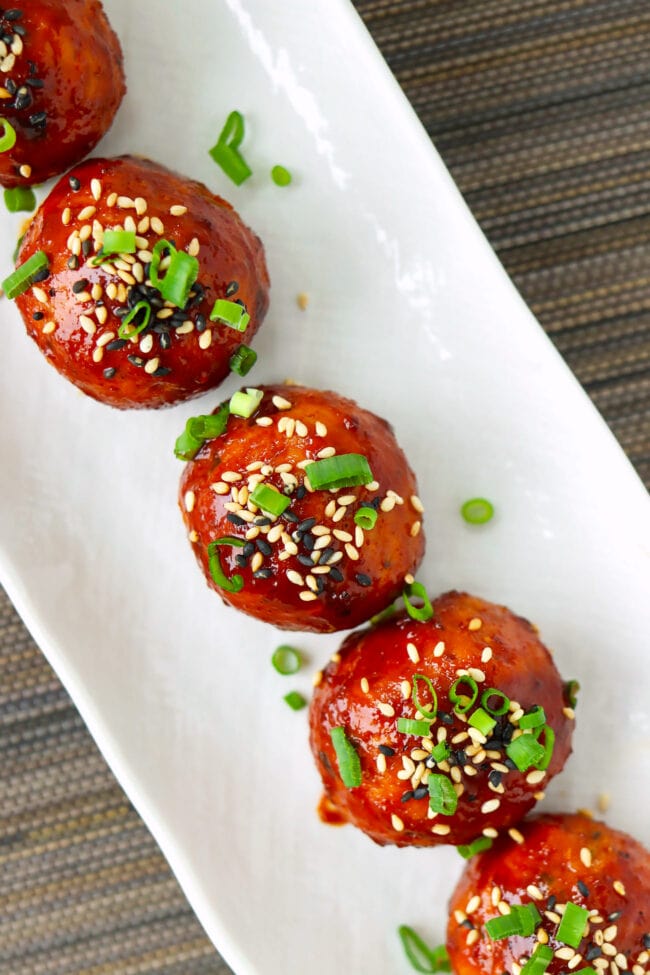
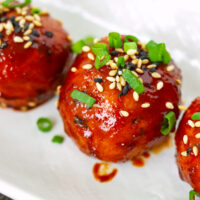
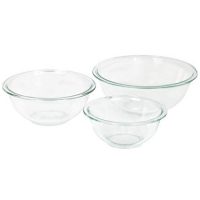
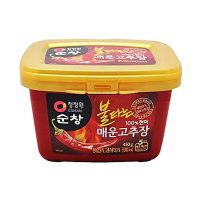
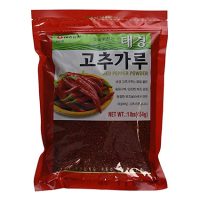







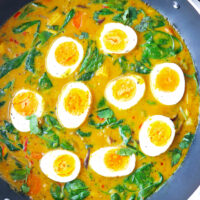


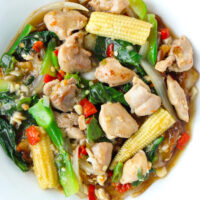






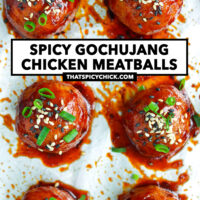

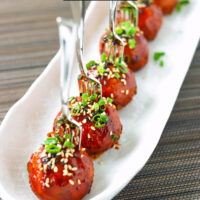
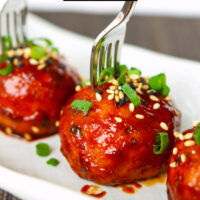

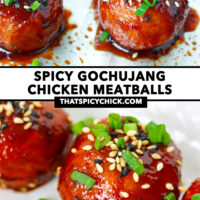
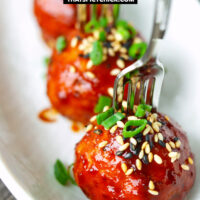

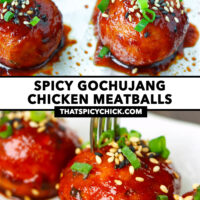
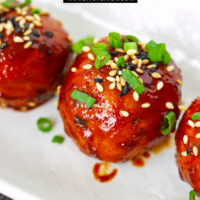


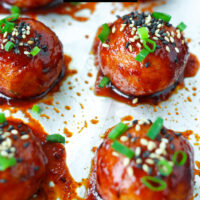
These were delicious! It was a myriad of flavors tantalizing my taste buds. ! Wow.! I followed your recipe exactly as your wrote it. My only difference was that I used my air fryer which cause a nice crispness on the outside and a very moist inside !
Thank you so much for sharing
Fantastic, Martha! I’m so glad you enjoyed the flavors in these meatballs! It’s great to know that these worked well in the air fryer too. Thanks for coming back to leave a comment and rating! 🙂